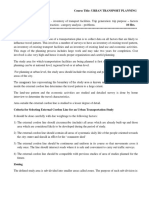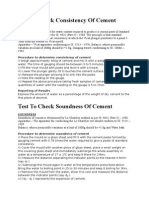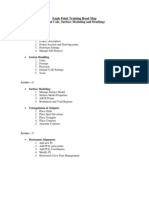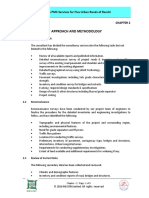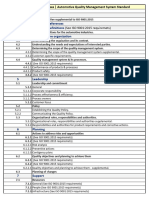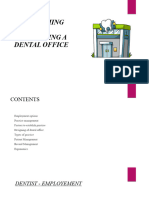Rationale For Rics Data Collection - R1
Rationale For Rics Data Collection - R1
Uploaded by
Anonymous CPEha1db7UCopyright:
Available Formats
Rationale For Rics Data Collection - R1
Rationale For Rics Data Collection - R1
Uploaded by
Anonymous CPEha1db7UOriginal Description:
Original Title
Copyright
Available Formats
Share this document
Did you find this document useful?
Is this content inappropriate?
Copyright:
Available Formats
Rationale For Rics Data Collection - R1
Rationale For Rics Data Collection - R1
Uploaded by
Anonymous CPEha1db7UCopyright:
Available Formats
Provision of Consultancy Services to undertake Road Inventory Road Inventory and Condition Data Collection
and Condition Survey for Coastal Zone in Kenya Manual for Classified and Narrow Roads
February 2018
2. RATIONALE FOR ROAD INVENTORY AND CONDITION SURVEYS DATA COLLECTION
2.1 ROAD ASSET MANAGEMENT
A road network is an asset that provides huge benefits to society (ERF RAM
Working Group, 2014). Strategic investment in the road network will not only
drive efficient flow of goods and services in the economy but will also deliver safe
and comfortable mobility for the citizenry, among other benefits.
Asset Management is a novel approach that is increasingly being adopted and
applied to the strategic management of roads. Asset Management may be
defined as a systematic process of maintaining, upgrading, and operating
physical assets cost-effectively. It combines engineering principles with sound
business practices and economic theory, and it provides tools to facilitate a more
organized, logical approach to decision-making. Thus, asset management
provides a framework for handling both short- and long-range planning (U.S.
Department of Transportation, 1999).
Road Asset Management (RAM) may thus be defined as a systematic process of
maintaining, upgrading and operating road assets – the physical plant (highways,
bridges, transit systems, etc., including the human element and other support
assets – combining engineering principles with sound business practice and
economic rationale and providing tools to facilitate a more organized and flexible
approach to making the decisions necessary to achieve the public’s expectations
(OECD, 2001).
2.2 REQUIREMENTS FOR ROAD ASSET MANAGEMENT
The European Union Road Federation Road Asset Management (ERF RAM)
Working Group has identified the basic requirements for road asset management
as:
i. Establish a complete inventory of all road network with all its elements;
ii. Provide a clear picture of the current condition/ performance of the road
network;
iii. Estimate the value of the asset;
iv. Predict future demand of traffic and service needs;
v. Estimate maintenance needs and costs;
vi. Prioritize objectives related to the desired quality and performance of the
road network;
vii. Set up funding scenarios for the regular and timely maintenance and
upgrade of the road asset;
viii. Define a strategy (RAM Plan);
ix. Implement the RAM Plan.
Intercontinental Consultants and in Joint Venture Page
GEODEV (K) Ltd., Kenya
Technocrats Pvt. Ltd. (ICT), India with 2-1
Provision of Consultancy Services to undertake Road Inventory Road Inventory and Condition Data Collection
and Condition Survey for Coastal Zone in Kenya Manual for Classified and Narrow Roads
February 2018
According to (OECD, 2001), the term (Road) Asset Management System
embraces all the processes, tools, data and policies necessary to achieve the goal
of effectively managing (road) assets. A Road Asset Management System (RAMS)
becomes necessary because of the inherent complexity of RAM. Over the years,
a number of jurisdictions have adopted RAMS with relative success (McPherson
& Bennett, 2005).
2.3 LEVELS AND TYPES OF DATA COLLECTED IN RICS
In general, RICS data is collected at three main levels:
i. Network-level data which is generally used for planning, programming, and
policy decisions for the network-level RMS;
ii. Project-level data which supports decisions about the best treatment to
apply to a selected section of road.
iii. Research-level data which is collected to answer selected questions.
The current RICS is a network-level assignment. The level notwithstanding, the
following data is generally collected for road asset management during RICS.
Table 2.1: Types of Data Collected in RICS
Type of
Details Frequency
data
Road Network/Location, Typically collected in a once-off exercise, then
inventory Geometry, updated when changes are made to the road. It
Furniture/Appurten is common to verify/update the data every five
ances, Environs years or so.
Pavement Pavement Structure, Often collected at different frequencies,
Pavement Condition depending on the road class. Main roads and
major highways are monitored more frequently,
often 1-2 years, while minor roads may be
monitored at 2 – 5 year intervals. The frequency
needs to be sufficient to identify major changes
which influence road maintenance decisions.
Structures Structures Often collected in two cycles. Regular surveys
Inventory, Bridge are conducted at 1 – 2 year intervals for
Condition collecting general data on bridge conditions.
More intensive investigations are done at longer
intervals, typically on the order of five years.
2.4 RATIONALE FOR RICS
Following the requirements outlined in Section 2.2 above, it is notable that the
current RICS commissioned by Kenya Roads Board (KRB), or any RICS for that
matter, aims at addressing the top two basic requirements for RAM i.e. establish
Intercontinental Consultants and in Joint Venture Page
GEODEV (K) Ltd., Kenya
Technocrats Pvt. Ltd. (ICT), India with 2-2
Provision of Consultancy Services to undertake Road Inventory Road Inventory and Condition Data Collection
and Condition Survey for Coastal Zone in Kenya Manual for Classified and Narrow Roads
February 2018
a complete inventory of all road network with all its elements and to provide a
clear picture of the current condition/ performance of the road network.
Overall, RICS at the network level is intended to yield a reliable repository of road
information that will inform decisions on Road Asset Management across the
Country. RICS data provides a detailed view of the road conditions in the Country
which in turn informs decisions on interventions to be applied to preserve or
improve the value of the road asset. As such, the inventory of the road asset
provides a tool for policy and decision making with regards to service delivery to
the public. For instance, it is from this roads data that rural accessibility indices
can be determined. Road assets are also inventoried with a view of estimating
the value of road furniture and investment.
Whilst no sector-wide RAMS exists in Kenya as yet (Mott MacDonald, 2015), data
collected in RICS is currently used by the road agencies as baseline data for road
asset management and is therefore an essential ingredient of any future RAMS in
the sector.
Intercontinental Consultants and in Joint Venture Page
GEODEV (K) Ltd., Kenya
Technocrats Pvt. Ltd. (ICT), India with 2-3
You might also like
- Individual Membership-EIZ Application Form-10Document4 pagesIndividual Membership-EIZ Application Form-10Timothy KapungweNo ratings yet
- Construction Technology Assignment 2Document5 pagesConstruction Technology Assignment 2Otee IsaacNo ratings yet
- A Second Generation Pms For The Ministry of Transportation of OntarioDocument15 pagesA Second Generation Pms For The Ministry of Transportation of OntarioElliot VanceNo ratings yet
- Foundation Method Statement: Uganda Electricity Transmission Corporation Limited. UETCLDocument20 pagesFoundation Method Statement: Uganda Electricity Transmission Corporation Limited. UETCLAnonymous CPEha1db7UNo ratings yet
- Amazon FlywheelDocument11 pagesAmazon FlywheelSAYAN HARINo ratings yet
- Guidelines For Engineering Reports FOR Wastewater Projects: Oklahoma Funding Agency Coordinating TeamDocument24 pagesGuidelines For Engineering Reports FOR Wastewater Projects: Oklahoma Funding Agency Coordinating Teamjherson gravidesNo ratings yet
- Pavement Forecasting ModelsDocument44 pagesPavement Forecasting ModelsAntonio RossiNo ratings yet
- Abdurehman MuletaDocument124 pagesAbdurehman MuletaHundee Hundumaa100% (2)
- Uganda Visa FormDocument2 pagesUganda Visa FormKss selvaNo ratings yet
- License QGISDocument30 pagesLicense QGISJuan PulgarinNo ratings yet
- Survey Notes Civil Engineering Sem1Document28 pagesSurvey Notes Civil Engineering Sem1ashishNo ratings yet
- Unit - 2 UTPDocument11 pagesUnit - 2 UTPArun NesamNo ratings yet
- Test For CementDocument9 pagesTest For CementSrinath KamathNo ratings yet
- Diploma SyllabusDocument324 pagesDiploma SyllabusCindy JonesNo ratings yet
- Experimental Investigation of Load Deflection Characteristics of Beam With Various End Conditions of Different MaterialsDocument5 pagesExperimental Investigation of Load Deflection Characteristics of Beam With Various End Conditions of Different MaterialsInternational Journal of Innovative Science and Research Technology100% (2)
- Final Year Project Report Format PDFDocument36 pagesFinal Year Project Report Format PDFMahaboob PashaNo ratings yet
- المواصفات العامة للهاتف - وزارة المواصلاتDocument22 pagesالمواصفات العامة للهاتف - وزارة المواصلاتAmir AmaraNo ratings yet
- Civil EngineeringDocument5 pagesCivil EngineeringAshishKumbhareNo ratings yet
- Aec Internship ReportDocument47 pagesAec Internship ReportBishal MondalNo ratings yet
- Introduction To SurveyingDocument5 pagesIntroduction To SurveyingAlone TimeNo ratings yet
- ToR Construction EngineerDocument6 pagesToR Construction Engineeryamanta_rajNo ratings yet
- Chika Walter ReportDocument31 pagesChika Walter ReportUrephu Isreal Avwerosuoghene100% (1)
- Comparative Design of Flexible Pavement Using Different Countries' MethodologiesDocument4 pagesComparative Design of Flexible Pavement Using Different Countries' MethodologiesIJSTENo ratings yet
- Passenger Car EquivalentsDocument130 pagesPassenger Car EquivalentsHarry NovfriandiNo ratings yet
- 3rd Sem - Civil EngineeringDocument26 pages3rd Sem - Civil Engineeringanirbanpwd7650% (2)
- Water 3.1 Feasibility Study PreparationDocument21 pagesWater 3.1 Feasibility Study PreparationameerNo ratings yet
- ThesisDocument69 pagesThesis2mhabibuNo ratings yet
- Plain Scale: This Type of Scale Represents Two Units or A Unit and It's Sub-DivisionDocument4 pagesPlain Scale: This Type of Scale Represents Two Units or A Unit and It's Sub-DivisionSai Tharun0% (1)
- BID Notice Jaffna Kaithady Elders' Home RenovationDocument1 pageBID Notice Jaffna Kaithady Elders' Home RenovationnpgovlkNo ratings yet
- Proforma PC-II (Survey Feasbility Study) PDFDocument3 pagesProforma PC-II (Survey Feasbility Study) PDFMaryam ali Kazmi100% (1)
- Draft TORs For PHE Water Supply SchemesDocument4 pagesDraft TORs For PHE Water Supply SchemesAmir_Jamal_QureshiNo ratings yet
- مكتبة نور مشروع خرسانة 2 3 PDFDocument220 pagesمكتبة نور مشروع خرسانة 2 3 PDFAsra AliNo ratings yet
- Human Resource Policies and Procedures Manual For The Public ServiceDocument163 pagesHuman Resource Policies and Procedures Manual For The Public ServiceAMANANG'OLE BENARD ILENYNo ratings yet
- Greater Hyderabad Municipal CorporationDocument4 pagesGreater Hyderabad Municipal CorporationNamrathaNo ratings yet
- Concrete Form WorkDocument3 pagesConcrete Form Workjack.simpson.changNo ratings yet
- Measurement of Elevation, ContouringDocument69 pagesMeasurement of Elevation, ContouringJay BhavsarNo ratings yet
- MSC in Hydroinformatics at UNESCO-IHEDocument2 pagesMSC in Hydroinformatics at UNESCO-IHEMZALENDO.NETNo ratings yet
- Introduction To Civil Eng.8283109.powerpointDocument8 pagesIntroduction To Civil Eng.8283109.powerpointsandesh negiNo ratings yet
- Statie Stonex r2w ManualDocument583 pagesStatie Stonex r2w ManualAndrewClaudiuNo ratings yet
- Santulan vs. Executive Secretary GR No. L-28021, December 15Document24 pagesSantulan vs. Executive Secretary GR No. L-28021, December 15Juris MendozaNo ratings yet
- Civil Engineering Project Management KTU Notes Module 1Document13 pagesCivil Engineering Project Management KTU Notes Module 1shalu R FNo ratings yet
- 10.2 Engineering-Economics JRPDocument21 pages10.2 Engineering-Economics JRPm71593511No ratings yet
- Advanced Design PDFDocument494 pagesAdvanced Design PDFalvaro Ruiz Valdiviezo1No ratings yet
- Hexco LogbookDocument27 pagesHexco LogbookLawson Sango50% (2)
- Terms of Reference For Financial AdvisorDocument2 pagesTerms of Reference For Financial AdvisorJames Okwudili AgadaNo ratings yet
- Construction Labour Laws.-IndiaDocument4 pagesConstruction Labour Laws.-IndiaPramod M ChauguleNo ratings yet
- Job Description (49K2019)Document1 pageJob Description (49K2019)Asad Hayat WarraichNo ratings yet
- Geometric and Pavement Design of RaodwatDocument56 pagesGeometric and Pavement Design of RaodwatFelicien Sinabubaraga100% (1)
- APGLI Operational Guidelines English and TeluguDocument20 pagesAPGLI Operational Guidelines English and Telugunateshnagaraju1568No ratings yet
- Ca Mutation SurveysDocument10 pagesCa Mutation SurveysGiddy Joly'g MutuaNo ratings yet
- Road Classification inDocument3 pagesRoad Classification inNikesh DahalNo ratings yet
- Final Mini Project 1 ReportDocument31 pagesFinal Mini Project 1 Report20135A0120 PINNIKA RAMESHNo ratings yet
- Chapter 3 Engineering EconomicsDocument27 pagesChapter 3 Engineering EconomicsharoonNo ratings yet
- 1903404-Construction Techniques and PracticesDocument11 pages1903404-Construction Techniques and Practicesci_balaNo ratings yet
- 09-Series 9000 Ancillary WorksDocument51 pages09-Series 9000 Ancillary WorksTsegawbeztoNo ratings yet
- Eagle PointDocument2 pagesEagle PointIrfan Ali100% (1)
- Design and Fabrication of Rope Pump: Mohamed Abu Waseem RDocument5 pagesDesign and Fabrication of Rope Pump: Mohamed Abu Waseem Rimma coverNo ratings yet
- Aerial Photo and Satellite ImageriesDocument8 pagesAerial Photo and Satellite ImageriesPankaj KushwahaNo ratings yet
- Revit ArchitectureDocument5 pagesRevit ArchitectureKurumeti Naga Surya Lakshmana KumarNo ratings yet
- Understanding the Building Construction Process: Simply ExplainedFrom EverandUnderstanding the Building Construction Process: Simply ExplainedNo ratings yet
- A Prototype Gis-Based Road Pavement Information and Management SystemDocument17 pagesA Prototype Gis-Based Road Pavement Information and Management SystemMeet JaniNo ratings yet
- DPR Chapter 2 Approach and Methodology PDFDocument9 pagesDPR Chapter 2 Approach and Methodology PDFManinder VirdiNo ratings yet
- 22N051-MPK-MR Remmy-Const ChangesDocument9 pages22N051-MPK-MR Remmy-Const ChangesAnonymous CPEha1db7UNo ratings yet
- Office BlocksDocument4 pagesOffice BlocksAnonymous CPEha1db7UNo ratings yet
- 00 ContentsDocument8 pages00 ContentsAnonymous CPEha1db7UNo ratings yet
- Structural and M&E Design BriefDocument16 pagesStructural and M&E Design BriefAnonymous CPEha1db7UNo ratings yet
- Accomodation BlockDocument5 pagesAccomodation BlockAnonymous CPEha1db7UNo ratings yet
- Road - Bridge Inventory - Condition Survey Report July 2010Document126 pagesRoad - Bridge Inventory - Condition Survey Report July 2010Anonymous CPEha1db7UNo ratings yet
- Rev3 Bridges SummaryDocument5 pagesRev3 Bridges SummaryAnonymous CPEha1db7UNo ratings yet
- Financials For Aswa BridgeDocument16 pagesFinancials For Aswa BridgeAnonymous CPEha1db7UNo ratings yet
- Sno District: Road Name Bridge/River NameDocument10 pagesSno District: Road Name Bridge/River NameAnonymous CPEha1db7UNo ratings yet
- Preliminary Design of Climate Roads: Major Structures/BridgesDocument4 pagesPreliminary Design of Climate Roads: Major Structures/BridgesAnonymous CPEha1db7UNo ratings yet
- Adriko JacksonDocument29 pagesAdriko JacksonAnonymous CPEha1db7UNo ratings yet
- Financials For... Box CulvertDocument5 pagesFinancials For... Box CulvertAnonymous CPEha1db7UNo ratings yet
- Sno District: Road Name Bridge/River Name Crossing CodeDocument12 pagesSno District: Road Name Bridge/River Name Crossing CodeAnonymous CPEha1db7UNo ratings yet
- Sno District: Road Name Bridge/River NameDocument10 pagesSno District: Road Name Bridge/River NameAnonymous CPEha1db7UNo ratings yet
- Financials For Atire BridgeDocument17 pagesFinancials For Atire BridgeAnonymous CPEha1db7UNo ratings yet
- Sno District: Road Name Bridge/River NameDocument10 pagesSno District: Road Name Bridge/River NameAnonymous CPEha1db7UNo ratings yet
- Major Structures Climate Roads - VelocityDocument4 pagesMajor Structures Climate Roads - VelocityAnonymous CPEha1db7UNo ratings yet
- 4.6 Design of Drainage StructuresDocument4 pages4.6 Design of Drainage StructuresAnonymous CPEha1db7UNo ratings yet
- Hoima Substation DCPT ResultsDocument42 pagesHoima Substation DCPT ResultsAnonymous CPEha1db7UNo ratings yet
- Design Resolutions CombinedDocument7 pagesDesign Resolutions CombinedAnonymous CPEha1db7UNo ratings yet
- CNOOC-Montlhly Progress Report Rev 2Document29 pagesCNOOC-Montlhly Progress Report Rev 2Anonymous CPEha1db7UNo ratings yet
- Sno District: Road Name Bridge/River NameDocument10 pagesSno District: Road Name Bridge/River NameAnonymous CPEha1db7UNo ratings yet
- Oyinya - Daga at KM 7+300 BridgeDocument1 pageOyinya - Daga at KM 7+300 BridgeAnonymous CPEha1db7UNo ratings yet
- Industrial Sliding DoorsDocument40 pagesIndustrial Sliding DoorsAnonymous CPEha1db7UNo ratings yet
- Monthly Progress Report-Apr 16Document11 pagesMonthly Progress Report-Apr 16Anonymous CPEha1db7UNo ratings yet
- Measurement SheetDocument12 pagesMeasurement SheetAnonymous CPEha1db7UNo ratings yet
- Final Report 5 To PrintDocument71 pagesFinal Report 5 To PrintAnonymous CPEha1db7U100% (2)
- Marketing AspectDocument3 pagesMarketing AspectLoyd EnteresoNo ratings yet
- Different Types of ResumesDocument49 pagesDifferent Types of ResumesRakesh Setty0% (1)
- IATF 16949 Clauses PDFDocument5 pagesIATF 16949 Clauses PDFRanjeetNo ratings yet
- Organizational Behavior (1a) - Holy Angel UniversityDocument2 pagesOrganizational Behavior (1a) - Holy Angel UniversityChelsea DizonNo ratings yet
- Establishing and Maintaining A Dental OfficeDocument17 pagesEstablishing and Maintaining A Dental OfficeMinnuNo ratings yet
- Auditing and Quality AssuranceDocument3 pagesAuditing and Quality AssuranceNiyonzimaNo ratings yet
- Safety, Health and Environment Management System Overview: CheckDocument20 pagesSafety, Health and Environment Management System Overview: CheckMohamed Fawzy100% (1)
- AboutDocument2 pagesAboutprabhav2050No ratings yet
- QA Interview QuestionsDocument28 pagesQA Interview QuestionsHassaan Naeem100% (1)
- CHAPTER 5 Case StudiesDocument2 pagesCHAPTER 5 Case Studiesharnoor KaurNo ratings yet
- Quality Assurance and Quality Control-Master ListDocument2 pagesQuality Assurance and Quality Control-Master Listaftabshekh624462No ratings yet
- M o B Material25 5-21Document93 pagesM o B Material25 5-21Venkat KiranNo ratings yet
- Mids AnswersDocument9 pagesMids AnswersNOOB4 LIFENo ratings yet
- Cost Leadership, Differentiation and Niche Strategies AssignmentDocument19 pagesCost Leadership, Differentiation and Niche Strategies AssignmentDoris AchengNo ratings yet
- Account Director Sales Executive in Denver CO Resume Dana BriscoeDocument3 pagesAccount Director Sales Executive in Denver CO Resume Dana BriscoeDana BriscoeNo ratings yet
- Unilever Analysis: Group Members: Dhaifina Idznitia Nurul Fithri Sylvani Amasel A. Swasono Isradila Lui Anbar RhainataDocument171 pagesUnilever Analysis: Group Members: Dhaifina Idznitia Nurul Fithri Sylvani Amasel A. Swasono Isradila Lui Anbar RhainataevanshjtNo ratings yet
- Connect Week 1 1st Series of Problems 1 Through 8Document14 pagesConnect Week 1 1st Series of Problems 1 Through 8Kevin MatthewsNo ratings yet
- Portfolio MANAGEMENTDocument10 pagesPortfolio MANAGEMENTBhavesh YadavNo ratings yet
- Jeric Risma - Module 4 ApplicationDocument8 pagesJeric Risma - Module 4 ApplicationJeric RismaNo ratings yet
- Notes To Financial Statement: Kim Nicole M. Reyes, CPADocument19 pagesNotes To Financial Statement: Kim Nicole M. Reyes, CPAAbby ManilaNo ratings yet
- Re-Engineering Operations: Marketing Financial Services - Product, Process and Pricing-Special Reference To B AnksDocument10 pagesRe-Engineering Operations: Marketing Financial Services - Product, Process and Pricing-Special Reference To B Ankshk_scribdNo ratings yet
- Lead ManagementDocument23 pagesLead Managementkaran100% (2)
- FO8 Audit Report - 14001 - v3.0Document18 pagesFO8 Audit Report - 14001 - v3.0frederic EDIOH PEMNo ratings yet
- Week 1 SlidesDocument26 pagesWeek 1 SlidesAnthony backupNo ratings yet
- Product Design and Value EngineeringDocument2 pagesProduct Design and Value EngineeringNikunj K0% (1)
- Chap 4 - Requirements Engineering 1Document15 pagesChap 4 - Requirements Engineering 1Paramveersinh DabhiNo ratings yet
- Board of DirectorsDocument2 pagesBoard of DirectorsCrina RizeaNo ratings yet
- Final Assignment of Business ManagementDocument12 pagesFinal Assignment of Business ManagementMuhammad IshfaqNo ratings yet
- SI-PI, Sulastri, Hapzi Ali, Information System in Ecommerce A Case Study of Efirst Asia, Mercu Buana University, 2019Document23 pagesSI-PI, Sulastri, Hapzi Ali, Information System in Ecommerce A Case Study of Efirst Asia, Mercu Buana University, 2019Achy AccountingNo ratings yet











